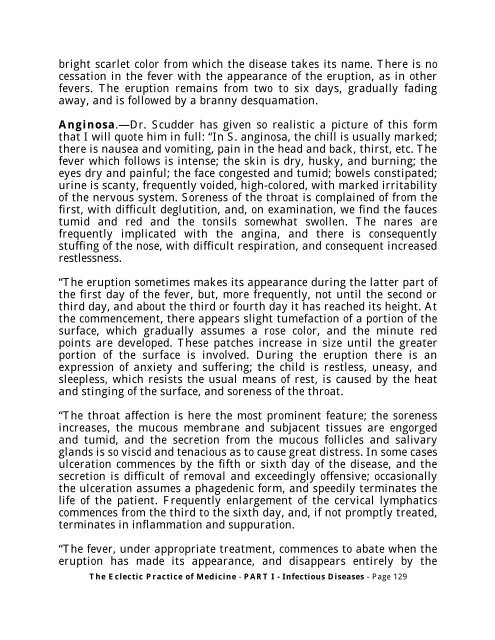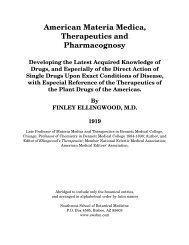SCARLET FEVER. Synonyms.—Scarlatina; Scarlet Rash. Definition ...
SCARLET FEVER. Synonyms.—Scarlatina; Scarlet Rash. Definition ...
SCARLET FEVER. Synonyms.—Scarlatina; Scarlet Rash. Definition ...
You also want an ePaper? Increase the reach of your titles
YUMPU automatically turns print PDFs into web optimized ePapers that Google loves.
ight scarlet color from which the disease takes its name. There is no<br />
cessation in the fever with the appearance of the eruption, as in other<br />
fevers. The eruption remains from two to six days, gradually fading<br />
away, and is followed by a branny desquamation.<br />
Anginosa.—Dr. Scudder has given so realistic a picture of this form<br />
that I will quote him in full: “In S. anginosa, the chill is usually marked;<br />
there is nausea and vomiting, pain in the head and back, thirst, etc. The<br />
fever which follows is intense; the skin is dry, husky, and burning; the<br />
eyes dry and painful; the face congested and tumid; bowels constipated;<br />
urine is scanty, frequently voided, high-colored, with marked irritability<br />
of the nervous system. Soreness of the throat is complained of from the<br />
first, with difficult deglutition, and, on examination, we find the fauces<br />
tumid and red and the tonsils somewhat swollen. The nares are<br />
frequently implicated with the angina, and there is consequently<br />
stuffing of the nose, with difficult respiration, and consequent increased<br />
restlessness.<br />
“The eruption sometimes makes its appearance during the latter part of<br />
the first day of the fever, but, more frequently, not until the second or<br />
third day, and about the third or fourth day it has reached its height. At<br />
the commencement, there appears slight tumefaction of a portion of the<br />
surface, which gradually assumes a rose color, and the minute red<br />
points are developed. These patches increase in size until the greater<br />
portion of the surface is involved. During the eruption there is an<br />
expression of anxiety and suffering; the child is restless, uneasy, and<br />
sleepless, which resists the usual means of rest, is caused by the heat<br />
and stinging of the surface, and soreness of the throat.<br />
“The throat affection is here the most prominent feature; the soreness<br />
increases, the mucous membrane and subjacent tissues are engorged<br />
and tumid, and the secretion from the mucous follicles and salivary<br />
glands is so viscid and tenacious as to cause great distress. In some cases<br />
ulceration commences by the fifth or sixth day of the disease, and the<br />
secretion is difficult of removal and exceedingly offensive; occasionally<br />
the ulceration assumes a phagedenic form, and speedily terminates the<br />
life of the patient. Frequently enlargement of the cervical lymphatics<br />
commences from the third to the sixth day, and, if not promptly treated,<br />
terminates in inflammation and suppuration.<br />
“The fever, under appropriate treatment, commences to abate when the<br />
eruption has made its appearance, and disappears entirely by the<br />
The Eclectic Practice of Medicine - PART I - Infectious Diseases - Page 129

















